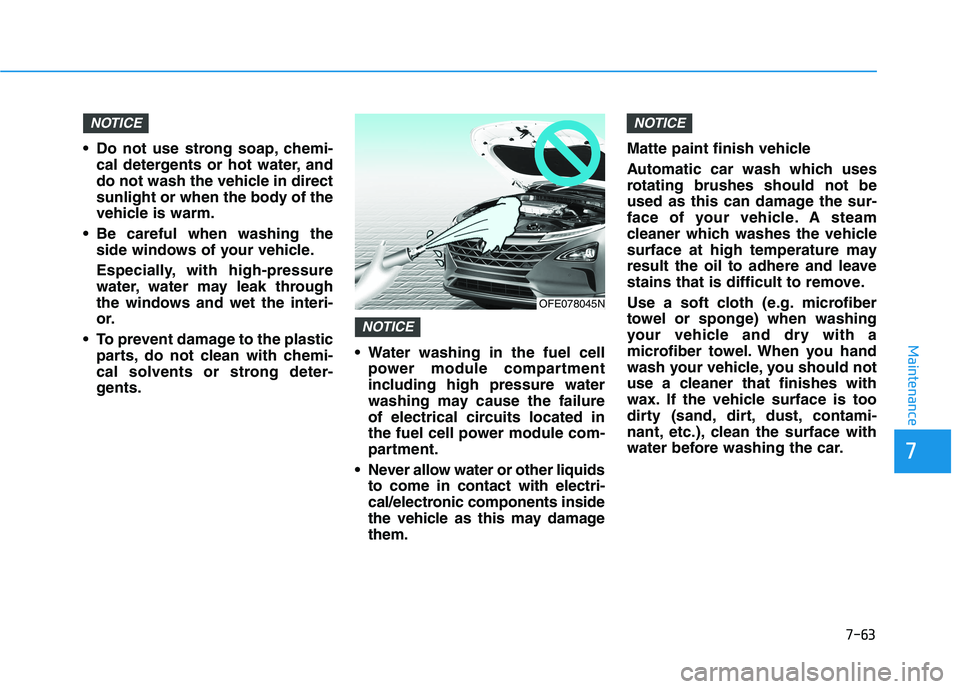Page 488 of 561

7-63
7
Maintenance
Do not use strong soap, chemi-cal detergents or hot water, and
do not wash the vehicle in direct
sunlight or when the body of the
vehicle is warm.
Be careful when washing the side windows of your vehicle.
Especially, with high-pressure
water, water may leak through
the windows and wet the interi-
or.
To prevent damage to the plastic parts, do not clean with chemi-
cal solvents or strong deter-
gents. Water washing in the fuel cell
power module compartment
including high pressure water
washing may cause the failure
of electrical circuits located in
the fuel cell power module com-
partment.
Never allow water or other liquids to come in contact with electri-
cal/electronic components inside
the vehicle as this may damage
them. Matte paint finish vehicle
Automatic car wash which uses
rotating brushes should not be
used as this can damage the sur-
face of your vehicle. A steam
cleaner which washes the vehicle
surface at high temperature may
result the oil to adhere and leave
stains that is difficult to remove.
Use a soft cloth (e.g. microfiber
towel or sponge) when washing
your vehicle and dry with a
microfiber towel. When you hand
wash your vehicle, you should not
use a cleaner that finishes with
wax. If the vehicle surface is too
dirty (sand, dirt, dust, contami-
nant, etc.), clean the surface with
water before washing the car.
NOTICE
NOTICE
NOTICE
OFE078045N
Page 548 of 561

H43
CategoryQuestionsAnswers
Vehicle
Accidents/
Towing
(5 items)
43. Is there a risk of electric shock from the
high-voltage parts in the event of a colli-
sion or accident?
The FCEV is designed to detect impact events during a collision or
accident so that the hydrogen gas supply is immediately cutoff. Also,
the high-voltage relay is activated to cutoff the supply of electric power
to the fuel cell stack and high-voltage battery. Moreover, the FCEV
satisfies international electrical safety standards for collisions and
accidents.
44. Should I take any special safety precau-
tions in the event of a collision or acci-
dent?
Despite the uniqueness of the hydrogen FCEV, you do not have to
take any special safety precautions in the event of a minor collision or
accident. In the event of a minor accident, turn off the vehicle to cutoff
the supply of electric power and hydrogen gas. Also, the FCEV is
equipped with collision sensors at the front and rear of the vehicle so
those sensors are activated during an actual collision to automatically
cutoff the supply of power and hydrogen to ensure driver and passen-
ger safety. For other situations, follow the same procedures as you
would with a standard vehicle. Depending on the severity of the colli-
sion or accident, take appropriate measures.
45. Is a high-voltage battery designed to
ensure occupant safety? Can it explode
from a collision?Our battery packs are designed to prevent any explosion due to
physical impact or damage, and they fully satisfy international safety
standards.
Page 549 of 561
H44
CategoryQuestionsAnswers
Vehicle
Accidents/
Towing
(5 items)
46. Is a hydrogen tank designed to ensure
occupant safety? Can it explode from a
collision?The hydrogen tank is designed to prevent any risk of explosion. It is
completely safe.
47. How should the FCEV be towed, and
what precautions should be taken?
The FCEV can be towed in the same manner as standard vehicles. If
you need emergency towing, it is recommended that you contact an
authorized HYUNDAI dealer. To avoid damage to the vehicle, you
need to follow proper pulling and towing procedures. The FCEV is
equipped with a front wheel drive (FWD) motor, so use a flatbed or
wheel dolly to tow the vehicle. If the front wheels touch the road sur-
face while being towed, they will rotate and this can cause the FWD
motor to generate electricity. This can cause unwanted failure of the
FCEV.
C CU
US
ST
TO
OM
ME
ER
R
Q
Q&
&A
A
G
GU
UI
ID
DE
E
(
(C
CO
ON
NT
T.
.)
)
Page 560 of 561

I-10
Tires and wheels ......................................................7-29, 8-4
Tire Care .....................................................................7-29
Recommended Cold Tire Inflation Pressures.............7-30
Check Tire Inflation Pressure .....................................7-31
Tire Rotation...............................................................7-32
Wheel Alignment and Tire Balance ...........................7-33
Tire Replacement........................................................7-33
Wheel Replacement....................................................7-34
Tire Traction ...............................................................7-34
Tire Maintenance ........................................................7-34
Tire Sidewall Labeling ...............................................7-34
Tire Terminology and Definitions ..............................7-38
All Season Tires .........................................................7-42
Summer Tires .............................................................7-42
Snow Tires ..................................................................7-42
Radial-Ply Tires ..........................................................7-42
Low Aspect Ratio Tires ..............................................7-43
Towing ............................................................................6-24
Towing Service ...........................................................6-24
Removable Towing Hook...........................................6-25
Emergency Towing.....................................................6-26
Trailer Towing...............................................................5-131
Trip Computer .................................................................3-85USB Charger .................................................................3-169
Vehicle Certification Label ...............................................8-7
Vehicle Identification Number (VIN) ...............................8-7
Vehicle Load Limit .......................................................5-126
Tire Loading Information Label...............................5-126
Vehicle Stability Management (VSM)............................5-34
Volume and Weight ...........................................................8-5
Washer fluid ....................................................................7-20
Checking the Washer Fluid Level ..............................7-20
Welcome System.............................................................3-99
Windows .........................................................................3-33
Power Windows..........................................................3-34
Windshield Defrosting and Defogging .........................3-158
Auto Defogging System (Additional Feature
with Automatic Temperature Control System) .....3-160
Rear Window Defroster............................................3-161
Winter Driving ..............................................................5-122
Snow or Icy Conditions............................................5-122
Winter Precautions ...................................................5-124
Index
U
V
W